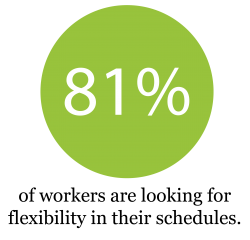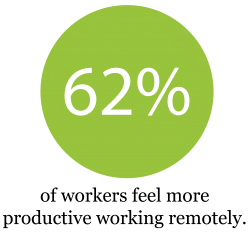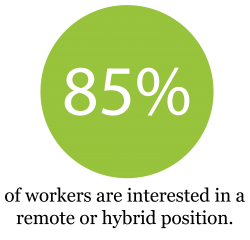
Midjourney.
The pandemic dramatically changed how we see remote and hybrid work environments – and that’s an understatement.
Even though many employers thought they’d fully return to the office some day, companies are now looking to the future, and there is a growing recognition that the traditional 9-to-5 office model may not be the best way forward. Employee interest in going to the office full-time has dropped by 24% since 2021, and for remote work, it increased by 24%.
Fully in-office, hybrid, and remote work arrangements are all valuable and have their own advantages and disadvantages, however. We’ve learned that success in each of these environments is found by properly leveraging camaraderie, productivity, training and development, and flexibility.
We spoke with four sales industry leaders from a variety of companies to learn their strategies and how they leverage these aspects of work: Will Sheu (former field sales manager at Penske), David Sevitt (chief revenue officer of Giftagram), Nicolas Thierault (sales director at Indeed), and Aubrey Baron (senior director of growth).
With the help of these leaders, this article will explore the intricacies of remote, hybrid, and fully in-office work arrangements, and offer insights on how to make the most of each setup. For each arrangement, you’ll first hear from the leaders, followed by a list of the main advantages and challenges you’ll find in the work environment.
Regardless of which arrangement you choose, the goal should be to create a healthy and productive work environment that supports the well-being of employees – and the success of the organization.
Jump to a specific section here:
–

Midjourney.
In-office work:
In-office work environments have been a cornerstone of modern employment for decades. Being in an office has a range of benefits that cannot always be replicated in a remote or hybrid setting, including social interaction and increased collaboration.
For Will Sheu, former field sales manager at Penske, this is the biggest draw: working in an office “better enables you to connect with your team, and it helps you get to know people,” he says. For many, “Virtual relationship building is not the same as in person relationship building, whether it’s with customers or internal people.”
That’s because there’s less opportunity for communication and rapport working remotely. Sending a message or setting up a meeting takes effort, where in an office you might bump into someone in the hall and chat.
And if text-based communication is your go-to remotely, then body language, facial expressions and gestures that help give you a sense of your coworker’s personality are lost.
Even with more opportunities to connect, however, building a sense of camaraderie isn’t a given in the office — it takes time and effort to establish. Will’s advice is “just to really genuinely get to know people,” he says. “It’s about each person taking the time to care about the people that they work with. Once you understand a person, with feelings, empathy and challenges, I think camaraderie comes from that.”
But all this easy access to direct communication has a catch. With so many distractions in the modern office, like hallway chats or popping out for coffee, productivity can take a hit.
–
“If I sense a lot of distraction,” Will says, “I ask people to have a strategy in terms of setting up time for themselves dedicated to projects or proposals, or whatever they’re working on, to really shut out the noise.”
–
Learning by osmosis can make training and development easier in the office, but an unexpected challenge is for trainers and managers themselves, Will says. When employees have questions and come to your office, it’s more difficult to stay focused on your projects than when working remotely, where you can finish what you’re doing and answer.

For flexibility, it’s a common misconception that in-office jobs don’t offer any scheduling leeway for stepping out to appointments or personal matters. Many in-office employers allow this flexibility, which is great because 81% of workers are looking for it in their schedules (Slack). You won’t find this in all in-office environments, though, and some workplaces will have a strict 9-5 schedule. Others might let you start and end later, say to take your kids to school in the morning.
If scheduling is more rigid in your workplace, or there’s no room for hybrid work at all, it’s important to make sure your job descriptions are detailed and expectations are crystal clear, so that well-suited employees hop onboard. “If people know where they’re stepping into, especially for new hires, it’s a lot easier,” Will says.
–
Considering bringing your team fully in-office? These are some advantages and common challenges:
Advantages:
- Relationship building – It’s often easier for in-office workers to build relationships with their colleagues through face-to-face interaction. When random encounters and conversations are common, developing a better understanding of each other’s strengths, weaknesses, and work styles becomes easier, which can strengthen teams as a whole.
- Learning through osmosis – Employees in offices learn from their colleagues simply by being in the same space and listening to each other, which is especially important in sales. Observing how others approach their calls makes it easier to pick up new skills and techniques, and you can ask questions in real-time. This is valuable for newer employees who could benefit from more seasoned professionals, and it can prevent knowledge gaps between senior leaders.
- Training and development – It can be easier to train and develop staff in an office environment where there’s more opportunity for direct contact (42% of employees found it more difficult to learn from their teammates remotely). Newer employees can benefit from immediate feedback and have more opportunities to ask important questions.
Challenges and solutions:
- Flexibility – In-office work can be challenging for employees who need flexibility in their work schedule due to family obligations, health concerns, or other personal reasons. To solve this, help employees achieve a better work-life balance by letting them step out when needed and allow them to make the time up.
- Productivity – Some people are very productive in-office, but for others it can be challenging to focus in a distracting environment. Provide these employees with a quiet, designated workspace where they can work without interruptions, or develop a strategy for the whole team to stay focused.
- Distance from the office – This can be a huge hindrance for in-office workers. Workers who need to travel an hour to the office each way lose a significant portion of their day, and the cost of transit or gas adds up. This can also make hiring a challenge, since you’ll be limited by geographical area or might need to pay for relocation. Solutions include offering transportation benefits to offset these costs, or implementing remote work options for days when employees find the commute too challenging.
–

Midjourney.
Remote work:
Workers around the globe have been embracing the work from home movement, and for good reason. Saving the time of long commutes, spending less on transportation, and being able to work from anywhere are key benefits, not to mention being able to focus more effectively and get more work done. It’s also important, however, to consider what’s being lost and how to get it back.
As a social being working remotely, senior director of growth Aubrey Baron missed the social interactions outside of scheduled meetings, like going to get coffee with a coworker or running into someone on the elevator and drumming up a conversation. “I felt like there was a bit of a gap in the beginning,” she says.
Many companies turned to happy hours and virtual events to encourage team building and camaraderie, but this wasn’t a strategy that stuck. “We saw a lot of people getting Zoom fatigue,” she says. “They wanted to go out and see their friends. They didn’t want to sit on their computer for an extra half an hour on a Friday and talk to their colleagues.”
Instead, Aubrey creates space for camaraderie in every interaction she has. Whether it’s a one on one, a team meeting, or text communication through Slack, “Take that time to ask somebody how they’re doing, or how their weekend was, and it just adds a human element,” she says.
–
“When it becomes something that people expect, they come excited to tell you about new things that are happening in their life.” And that’s a great opportunity to learn about team members and establish true connections.
–
Just like how there’s a misconception that in-office schedules are more strict with scheduling, the opposite is true for fully remote work. “You can work remotely and still not have flexibility,” Aubrey says. “Those are not hand in hand.” Aubrey chooses to take a flexible approach as a leader, saying that she only wants to provide people with guidelines, and that she trusts her team to know when they get their best work done.
For Aubrey, a main piece that’s missing for newer salespeople “is being able to organically learn from your peers,” she says. In a traditional sales office environment, people are sitting beside each other on their calls, hearing and picking up tactics and implementing them in future outreach. “It’s a lot different when you’re remote, you have your dog or your cat with you but they’re not giving you sales tips.”
To overcome this hurdle, Aubrey suggests assigning a high-performing team member to onboard new staff. Plus, they should have all day every day access to their assigned person through Slack or video chats to ensure their questions can always be answered. “I then make sure that my door is always open,” she says.
It’s also important to consistently ask for feedback as a leader, especially from people who are newer. Asking questions like: “What was your experience, what made you feel good, what would you change, or what have you seen at other companies that have worked or that hasn’t worked?” can give you valuable feedback that you can implement to build a thriving team.
This advice doesn’t just apply for newer team members. Consistently checking in with everyone on your team can open your eyes to what’s happening and how your team is feeling, then you can make adjustments as necessary. One question Aubrey likes to ask is: “How does working remotely feel to you this month?” she says. “Because something that may have felt great or may have been a struggle can change very quickly.”
–
Want to keep (or bring) your team remote? Keep these factors in mind:
Advantages:

- Productivity – Many employees can be more productive when working remotely — 62% of workers in a recent study from Owl Labs felt more productive — as there are less distractions than in your typical office environment. Additionally, remote work allows employees to work in a comfortable and personalized environment that can make it easier to focus and get work done (and, being within arms reach of snacks and your pets helps with motivation!).
- Flexibility – Remote work allows employees to have more control over their work schedule, which can be especially valuable for those with family obligations or other personal commitments. By eliminating the need for a daily commute and offering more flexibility in their work hours, employees can achieve a better work-life balance and reduce stress (not to mention it can save companies money in office costs!).
- Access to talent – Remote workers can get their jobs done from anywhere with an internet connection. This means they can spend less money and time on commutes, plus it opens up new opportunities for, say, employees who live in remote areas who can now apply for roles in larger cities. This opens up the talent pool tremendously, and many employers also allow remote workers to tweak their schedules to accommodate life requirements.
- Employee retention – Since work-life balance is such a priority for employees, offering this work arrangement can encourage your workers to stay with you longer. Although this applies to hybrid work as well, 66% of workers would start looking for a new job if their option to work from home was taken away, according to Owl Labs, and 39% would outright quit.
Challenges and solutions:
- Camaraderie – Employees who thrive on social interaction and camaraderie with their colleagues can find remote work challenging. One solution is for employers to encourage regular communication among team members, like with regular check-ins or daily meetings, to help build interpersonal connections.
- Training and development – It can be much more challenging for remote workers to learn new skills on the go, like they could through osmosis in a typical office environment. One solution for this challenge is to assign teammates together to have regular meetings and discuss their wins, losses, and what they’ve learned.
- Work-life balance – In a remote working environment, it can be easy for the lines between work and relaxation to blur, and for some people it can be a challenge to close their laptops at the end of the day and enjoy their off hours, leading to faster burnout. Workers can create designated workspaces, if possible, to help shift the focus away from work when leaving the space. Or, create a routine that signals the end of the workday for your brain, like putting your laptop away completely or writing out a list of wins and losses for the day.
- Communication – Talking with or managing colleagues can be more difficult in remote environments with less access to direct communication. Some workers might also be more easily distracted at home vs. in an office without direct guidance. So, leaders should specifically look for candidates who thrive working remotely, and have frequent check-ins with employees who need help staying productive.
–

Midjourney
Hybrid work:

Once pandemic restrictions began to ease, hybrid models became the dominant working arrangement. 85% of workers in a recent study were interested in hybrid or fully remote positions. It’s also what employers offer the most, with 74% of companies now offering hybrid working arrangements according to Forbes.
But, there isn’t just one way to set up a hybrid workplace. There are variables that you need to consider – will everyone in the office come in on the same days, what kind of office space are you using, and what work will be done remotely or in-person? And why is working hybrid effective in the first place?
For David Sevitt, chief revenue officer of Giftagram, it comes down to having the flexibility to work from home on the days that work for him, and being able to collaborate on projects in person with his team. “We’re building every day, and how we win or lose is going to be based on the pace of our decision making,” he says.
–
“There’s a lot of ideation and being able to throw ideas up on a whiteboard is really important to us. And that kind of work is, in our opinion, harder to do remotely.”
–
Even though not all teams are in the office on the same days, “there’s some overlap,” David says, “which is great because there’s cross pollination of ideas. There’s always a bit of a different mix of people.” Thanks to this overlap, hybrid environments can increase the probability of random encounters with people you might not normally see, which is helpful for establishing camaraderie.
In terms of development, “I think the point is to be thoughtful about what you’re doing in person and what you’re not doing in person for onboarding or training,” David says. Call shadowing, roleplays, team meetings, and deal audits are all training situations best done in person, since they benefit from in-person collaboration, while training centered around content absorption is best done remotely so that people can go at their own learning pace.
Some workplaces are taking creative approaches to ensure the happiness of hybrid employees. Nicolas Theriault, sales director at Indeed, and his team recently made the switch from remote to hybrid, and he says that “hybrid models are a bit more difficult than having a full remote or full in-office.” So, a task force was established to help create guidelines for success and determine different areas to work on.
“Basically, we broke into teams of four,” he says, “and each team worked on a component, including what we wanted meetings to look like, what training should look like in a virtual environment, and how to make sure it’s inclusive.” This type of solution allowed for a work environment where everyone was heard and had a say in what the hybrid setup felt like.
“We also make sure that we have a weekly wrap up when we’re virtual,” he says, which helps to maintain the collaborative and team-driven nature of the in-office side.
Despite its increasing popularity and its many benefits, hybrid work isn’t for everybody. David thinks job seekers in particular should take a step back and assess their strengths and weaknesses and how their work environment supports or hinders them. For example, some extroverts could really benefit from having the in-person communication of a hybrid or in-office environment. But without the proper reflection, they might end up taking fully remote jobs that aren’t suited for their needs and growth just because the company is compelling.
“I think this self-reflection is probably the first step in thinking about where to work,” he says, “because there’s major costs with choosing incorrectly for the individual.” It’s also costly for companies who might need to replace those candidates in the near future.
Just like in-office, setting clear expectations when hiring can help make sure you’re bringing on talent that will thrive. It’s key for candidates to “know exactly what to expect,” he says, “and then it’s about being consistent in living what you promise people.”
–
Keep these advantages and challenges in mind while setting up your hybrid work environment:
Advantages:
- Best of both worlds – The benefits of remote work and in-office shine in hybrid arrangements. Employees save time and money on commuting when working remotely, can do their work in a comfortable environment, and often have more control over their schedule. Employees can head to the office to benefit from the social interaction and collaboration that’s more difficult to achieve remotely.
- Flexible collaboration – Building a sense of community and shared purpose can be easier when employees are in the office, and hybrid environments allow for this while still giving employees the option of flexibility. This can improve employee retention overall, as flexible work arrangements and having colleagues and culture that inspire employees to do their best are both in the top five qualities sales professionals are looking for in their employers (Sales Talent Agency).
- Work-life balance – It’s often easier for employees to manage their personal and professional responsibilities while working hybrid, especially when there’s choice involved. Employees can work remotely on days with personal commitments or to focus on individual tasks, while still having the opportunity to collaborate and connect with colleagues in person on other days. This can lead to a better work-life balance, reduced stress levels, and increased job satisfaction.
Challenges and solutions:
- Establishing which days are in office – Some hybrid companies have all employees in-office on the same days to encourage collaboration, learning and team building, at the expense of some flexibility. Others let their employees choose which days to come into the office, which prioritizes flexibility over collaboration and team-building. Some departments have unique policies for this compared to others, which presents a challenge. A solution to ensure the happiness of employees is to ask for their feedback and preference, which makes it easier to create alignment.
- Productivity – When in the office, it can be more difficult for some people to get work done with constant distractions. To address this, employers can help their team develop a strategy to remain focused. It can also be difficult to be productive remotely for some people; establishing clear expectations and guidelines, including setting specific deadlines and providing regular feedback and support, can help.
- Camaraderie – If your team doesn’t come into the office on the same days, it can be challenging to foster a sense of camaraderie and connection between all members in a hybrid work environment. Try scheduling regular team meetings to bring together employees across different areas of the organization to encourage camaraderie company-wide.
–

Midjourney.
So, how do you choose between in-office, remote and hybrid work?
There isn’t a one-size-fits-all answer. Different teams will thrive in different environments, so instead, reflect on the following to help you make your decision:
- Your business — For some companies and industries, their sales process can easily be done remotely, while those that need more collaboration would likely benefit from being in-office. Think about the kind of work your business does and what environment will best support that.
- Your team — If you are considering making a switch or starting with a fresh new team, ask your employees for feedback and their preference to ensure alignment and happiness across the board. Then, make changes accordingly. When your team can work their best, your business will prosper. Also, think about whether you need a larger talent pool to hire from, or if your team will need lots of face-to-face learning, to help make your decision.
- Your leadership qualities — Are you a leader who can manage virtually, or do you find it easier in person? Setting up an environment where you can lead as efficiently as possible ensures your team has what they need to succeed.
Whether your team works in an office, remotely or in a hybrid environment, there are also common threads to consider.
For example, taking the time to build connections with your team, whether you’re together in a shiny office building or collaborating behind a screen, is the best way to build camaraderie. And, for all setups, making expectations clear in the hiring process will attract people to your team who will thrive.
Nicolas has some final words of wisdom for leaders from any work environment: “It’s important to know that as a leader, as long as you’re flexible, understanding and lead with empathy,” he says, “that’s the most important thing that you can do.”
